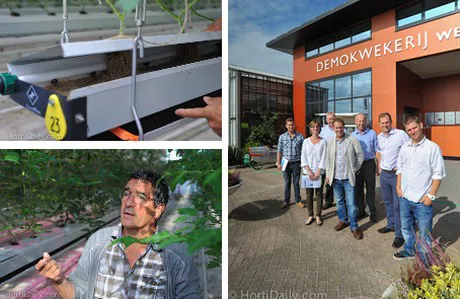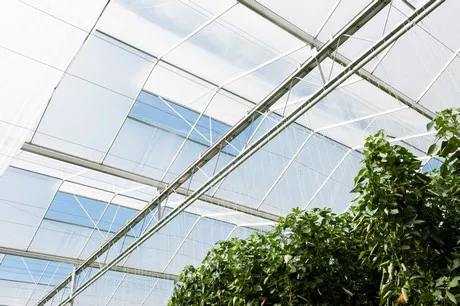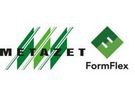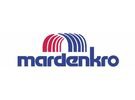On the first day, Ross Hibbs of Cambridge HOK toured with the group across the country to show them several operations. A first stop was made at the greenhouses of Looije Tomatoes (infamous grower behind the honey tomatoes) who is pioneering with the
ActivAir greenhouse. As well as this the group stopped at the greenhouse of Koppert Cress to take a closer look at the
water cooled LEDs of Lemnis and learn more about the unique and inspiring marketing concepts of Koppert Cress. Furthermore a visit was paid to
Greenwell Westland, where a consortium of greenhouse growers invested in a geothermal well to increase their energy efficiency. The first day ended with a tour at the GreenQ Improvement centre, where a keynote was held on the
GreenScheduler; an app that is able to make a crop planning based on the radiation, and in turn, the crop planning enables you to realize the optimum plant load.
 Click here for more pictures
Click here for more pictures
Futagrow
Also during the second day of the tour, the focus was on energy efficiency. The day started at the Demonursery in the Westland. Peet van Adrichem of the Demokwekerij gave a presentation about Futagrow. In the Futagrow trial, a year-round cultivation is realized with a suspended gutter system; The main principle of the system is a sequence of short cultivations where two crop stages in the greenhouse are growing continuously. The system is based on 5.6 short tomato cultivation per year, and each tomato plant only produces nine clusters (vines). Between the gutter rows with the fully grown crop, the young plants are growing, which makes a 365 days a year production possible. Every 8-9 weeks a crop change takes place and new strong young plants enter the greenhouse. This makes it possible to harvest very high quality fruit during the entire year.

The cultivation takes place in an oxygen-rich film of water, eliminating the need for substrate. The nutrient composition may be adjusted at any time of the day and stage of the cultivation. The young and full grown crop both use their own irrigation and fertilization schemes. Futagrow uses less water and fertilizers as the water is being recirculated all of the time. Every 24 hours the water is being treated by UV.

The Futagrow method can be an interesting way for commercial greenhouse growing and after several years of trialling, the system is ready to be put into practice on a commercial scale as the system has proven to be very cost efficient in respect to labour, energy efficiency and overall production output. Another big advantage is the reduced disease pressure; crops are being removed after 9 weeks, so the changes in having botirytus inside the greenhouse is minimal, also due the fact that no leafs are being cut. As well as this the biological life inside the greenhouse can become very efficient as there is always a strong population with natural enemies available.
According to Van Adrichem, the primary reason that Futagrow has not been put into practice by the Dutch is the poor economic situation and malaise in the domestic greenhouse market.
Diffuse coatings in the UK market
During the lunch, Paul van Gils of Mardenkro gave a presentation about the advantages of diffuse coatings in tomato cultivation. Mardenkro's ReduFuse coating allows a greenhouse roof to diffuse light without the need to rebuild or re-glaze. Van Gils clarified how growers can best use the coating in the English growing climate. ReduFuse produces a milder climate. Growers can achieve a better setting, heavier fruits and they suffer fewer quality problems. The coating is particularly suitable when the climate promotes generative growth, so when it is warm and dry. During the presentation Van Gils described that the coating is aimed at achieving a better quality first hand, and users should not expect increases in yield.
 Click here for more pictures
Click here for more pictures
Van Gils explained how the UK growers had to pay attention to both the time of application, as well as its removal. The rule of thumb is: Apply in mid April and remove at the end of August. The threshold is around 1600 J/day radiation. But it’s determined by the state of the crop. If the crop is still vigorous in the middle of April, or if the weather isn’t favourable, you’d better postpone it.

The coating has to be removed sometime after the longest day and before it becomes too damp. Again you need some common sense. If it is still very hot in the middle of August that’s a signal to wait a bit longer. If the weather is warm and humid (= vegetative) you’ll probably want more direct sunlight in the greenhouse.
Technokas
Peter Zwinkels of Technokas invited the Tomato Working Party to visit the ID-kas and Daylight greenhouse. The two innovative greenhouse concepts are designed by Technokas, and have become one of the most discussed greenhouse innovations of the past few year.

The Daylight Greenhouse
The Daylight greenhouse is a greenhouse structure that is based on the idea of saving a maximum amount of energy against the lowest production, whilst still having a equal or even better production output. The Daylight Greenhouse is a fully double glazed structure and has a fresnel lens in the double glazing, with a collector underneath.

The concept is used on 0.5 hectare of commercial floriculture production at Ter Laak Orchids. After years of trials and studies, Technokas build the concept for the leading Dutch Phaelenopsys grower. Peter Zwinkels explained the British growers how the system works. "The direct sunlight that enters the roof, and it is focussed into 3 beams by the 3 fresnel lenses. The beam shines on the collector, and the water in the collector pipes is being heated. The water is upgraded with 10 degrees Celsius, and this energy is being stored and re-used. Due to the fact that the roof is also diffusing the light, a screen is no longer needed.

The daylight greenhouse at Ter Laak Orchids uses little to no energy on balance, which is an incredible achievement. As well as this, the grower is able to achieve a better quality product in the greenhouse due to the equal, optimal light distribution inside.
The ID-KAS
Another impressive project from Technokas is the ID-kas that they built for the Dutch tomato grower Gebroeders Duyvesteijn. The idea behind the ID Kas is a greenhouse that uses low-grade heat, but still achieves a similar or better production compared to a conventional concept.

Duijvestijn Tomatoes is a large greenhouse grower that used geothermal energy. The energy of the low-temperature water from the geothermal well is normally not being used. Thanks to the innovative concept of the ID Kas, Duyvestijn can now use the low grade heat inside their greenhouse because the greenhouse is fully double glazed.
 Click here for more pictures
Click here for more pictures
But normally, a double glazed greenhouse would not be suitable for a greenhouse, due to the loss of light. Yet, Technokas designed a completely new greenhouse structure that allows more light to enter the greenhouse. Both layers are made of Scheuten's highly transmissive glass and are diffused. On top of this, an integrated dehumidification and air handling system at the gable and the gauze in the ventilation windows, allow the plants to grow in a uniform climate, environmentally friendly and energy saving greenhouse.
For more information on Futagrow :
Metazet/FormFlex
Arjan Kouwenhoven
T: +31 06-55821952
ArjanKouwenhoven@formflex.nlwww.formflex.nl Mardenkro
MardenkroJohn van Gils, Marketing
+31 (0)13-507 5382
John@mardenkro.comwww.redusystems.comFor more information on Redufuse:
For more information on the ID Kas and the Daylight Greenhouse:
 Technokas
TechnokasPeter Zwinkels
M 06 22 98 60 31
E-mail
peterzwinkels@technokas.nl www.technokas.nl











 Mardenkro
Mardenkro